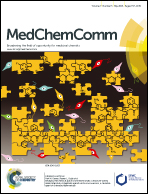Synthesis, antibacterial evaluation and QSAR analysis of Schiff base complexes derived from [2,2′-(ethylenedioxy)bis(ethylamine)] and aromatic aldehydes†‡
Abstract
Two new Schiff bases derived from 1-hydroxy-2-naphthaldehyde/2-hydroxy benzaldehyde with 2,2′-(ethylenedioxy)bis(ethylamine) and their organosilicon and organotin complexes have been synthesized and characterized by spectroscopic techniques (UV-vis, IR and NMR) in combination with elemental analyses. Spectroscopic studies suggest bonding between the central atom and ligands in a penta and hexacoordinated fashion. Derived complexes and their corresponding ligands were evaluated for their antibacterial activity against Gram positive bacteria viz. Staphylococcus epidermidis, Staphylococcus hominis and Gram negative bacteria viz. Pseudomonas aeruginosa and Klebsiella pneumoniae and this study revealed that compounds 29, 30 and 34 exhibited antibacterial activities even better than the standard drug ciprofloxacin. For most of the complexes, higher activity was observed on coordination with silicon and tin atoms compared to their respective ligands. Compounds 1–34 were selected for the QSAR analysis in order to correlate antibacterial activity with significant structural parameters. The statistical parameters used were Dipole, HOMO, CVolume and Total Energy.
![Graphical abstract: Synthesis, antibacterial evaluation and QSAR analysis of Schiff base complexes derived from [2,2′-(ethylenedioxy)bis(ethylamine)] and aromatic aldehydes](/en/Image/Get?imageInfo.ImageType=GA&imageInfo.ImageIdentifier.ManuscriptID=C5MD00554J&imageInfo.ImageIdentifier.Year=2016)

 Please wait while we load your content...
Please wait while we load your content...